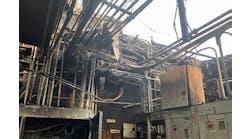Oil & gas panel tackles energy transition, digital challenges
“Users can get some quick wins with digitalization, and use them as a foundation for transitioning to a new world.” ExxonMobil’s Dave Hedge argues that the oil and gas industry must adopt digital tools to attract the new generation of technical professionals that will bring the industry forward.
Digital transformation may be one of the few saving graces that can help oil and gas producers cope with their roller-coaster, rapidly transitioning and COVID-19-impacted markets. However, as with any big shift, it's easier said than done.
The Oil & Gas Industry Forum, part of this week’s Automation Fair at Home event, played virtual host to five industry experts to explore these issues and consider possible solutions.
"The pace of transition in the energy industries is accelerating, but there's also a lot of demand destruction now, which has a long-term feel that makes it different than previous events," said Fred Wasden, Shell veteran and managing member at OptilytiX, a consultancy focused on accelerating asset value realization through data analytics and technology implementation for the energy industry. “The second trend is an overwhelming surge of digital technologies by process-industry users, which are being adopted after being risk-tested in other industries. We're also facing a big challenge in recruiting and retaining staff. It's an exciting time, but it's a lot of change all at once."
Dips inspire refocusing
Pal Roach, industry consultant, Oil & Gas, Rockwell Automation, added, "The present situation with COVID-19 is similar to past downturns. Much of the initial 30% dip in demand has been recovered, but we're still down 5-7%, and most estimates are that it will be slow to come back because so many more people are working at home. At the same time, even though demand for aviation fuel has collapsed, diesel fuel is up because there are so many Amazon and other trucks driving through neighborhoods. Some estimates are that demand will remain down 5-6% for 20 years, and some refineries will have to close. Others indicate the refining industry may grow 20% by 2040, but this will still be only a 1% increase per year.
"This is all impacted by the fact that refining is a unique business, which has little or no influence over the cost of its materials or the products it produces, and also has to deal with many regulations and safety requirements. The challenge is to optimize feedstocks and operations, and seek better performance and maintenance. The service side of refining took a big hit in 2014 due to pricing pressures on operators, causing some providers to exit the industry and refocus."
Chetan Desai, vice president of digital technologies at oilfield equipment and services supplier Schlumberger, explained that these challenges are causing the company’s upstream and midstream clients to sharpen their focus on portfolio management. "Especially in the past six weeks, we're seeing supply and demand imbalances, and efficiency and cost concerns, which are leading to an increased focus on total value creation, closer integration with service providers to scale up quality, and delivering greater value to asset operators. They're also focusing more sharply on existing operations, instead of exploring for new ones on the frontier."
Need to lead in new directions
To address these epic challenges, the panelists reported that new levels of leadership will be required across the oil and gas sector. "This really begins with a vision for success that addresses profit and safety, of course, but also acknowledges that greenhouse gas intensity has become a front-and-center metric, too,” said Wasden. “This means many leaders will have to adopt broader visions than they have in the past, and bring their priorities into balance.
"Previously, leaders might talk about 'people, planet and profit,' but the focus was still mostly profit,” he continued. “Now, they're going to have to deliver on all fronts. Fortunately, there are ways for oil and gas leaders and their organizations to do it. For example, just as we use the Waze app to navigate our commutes, we've tried equivalent software that can help with operating oil and gas fields, and they can deliver some significant benefits. For many leaders, the focus has been less on inventing new applications, and more on adapting existing software to their processes."
Aligning with digitalization
Because so many potentially useful technologies are emerging so quickly, Andy Weatherhead, chief technology officer at Sensia, reported that many of these technologies and their architectures are converging. "For example, cybersecurity capabilities are getting baked into many products, which is making them pervasive," he said. "Many applications are becoming increasingly virtualized at the same time that they're participating in open-source software communities like the Open Process Automation Forum (OPAF), or beginning to use fit-for-purpose sensors or self-organizing wireless components."
Desai added that one way to organize today's ever-shifting technology deluge is to ask "to what end?" and concentrate only on those that can solve specific problems. "The real problems are change management and adoption, and how to package and deliver solutions to users," explained Desai. "Digitalization can affect all the pieces in the full, cradle-to-grave lifecycle of many hydrocarbon assets, so we have to focus on the ones that can uplift performance across those lifecycles."
Roach cautioned these shifts aren't easy for process applications because they're so firmly based in physical settings. "Many process assets cost $100 million to $250 million or more, and are so complex that it's hard to develop digital representations, or build models of them that can indicate when they need support or maintenance," said Roach. "Digital twins of physical equipment are also costly up front, but once users have them, they can start to follow their physical counterparts for better performance of engineering, maintenance and support tasks. This is likely where most of the benefits will occur."
Dave Hedge, solution architect at ExxonMobil Information Technology, reported there are three main phases of digital transformation—initial data collection, taking and learning, and applying it back in the field—and that COVID-19 has accelerated all of these initiatives. "It's amazing what digital transformation can do, but the question suddenly became 'how can we get everyone onboard?' So, we need to get back to deciding on a common vision about what we need digitalization to do based on extracting value from our processes."
Culture lubricates, invests in transformation
The panelists unanimously agreed that a critical ingredient of digital transformation is encouraging cultural acceptance by operators, technicians, engineers, managers and other end users.
"The process operations landscape is still all about people," added Desai. "These staffers are demanding access to digitalized tools and retraining for machine learning (ML) and artificial intelligence (AI), and their companies will need digital dexterity to make it happen. Leaders will have to ask if their organization are agile enough and open to these changes. We all need to get proficient at using them. It's no longer enough to just be good: digital technology is needed to attract talent. Users running $20-50 million assets have FitBits on their wrists checking their heart rates, and they want the same technologies for their operations."
Hedge reported that recent graduates coming into the process industries have skills like Python programming, and want to use them to improve process industry applications, but they still need acceptance from veterans and managers to help the field move forward. "Upstream, midstream and downstream users are looking more closely at the data moving across their companies," added Hedge. "They want to 'see the molecules' moving from production to customers. All that data, from their premises and platforms, is coming in waves, and digitalization can help organize it.
"This also is why it's time to invest in digitalization. Fast return in investment is always needed, but users can get some quick wins with digitalization, and use them as a foundation for transitioning to a new world. We just need to make a few initial steps to get started. These are businesses that still need to make money, and digitalization can add to those bottom lines."
The editors of Control, Control Design and Smart Industry are providing coverage of Automation Fair At Home, bringing you breaking news, innovations and insights from the virtual event. Once Automation Fair At Home is over, the editors will put together an event report featuring the top news. Pre-order your copy today.







